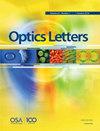光学纳米毛细管纤维上的单侧复合空腔。
IF 3.3
2区 物理与天体物理
Q2 OPTICS
引用次数: 0
摘要
本文报道了利用复合空腔对光学纳米毛细血管纤维(NCF)单侧空腔的数值研究。该复合腔由光学NCF和非对称缺陷模光栅组合而成。我们设计的腔体可以在从低耦合到临界耦合和过耦合的情况下实现高达80%的单侧nfc引导模式的最大通道效率。在最大通道效率的情况下,我们找到了最佳的性能参数,如质量因子、精细度和腔体的一通损耗。据我们所知,目前的平台可能为设计量子技术中基于光纤的确定性单光子源开辟了一条新颖的途径。本文章由计算机程序翻译,如有差异,请以英文原文为准。
One-sided composite cavity on an optical nanocapillary fiber.
We report on a numerical study of a one-sided cavity on an optical nanocapillary fiber (NCF) using a composite cavity. The composite cavity is formed by combining an optical NCF and an asymmetric defect mode grating. We design the cavity to realize the maximum channeling efficiency of up to ∼80% into one-sided NCF-guided modes while operating from under- to critical- and over-coupling regimes. For the maximum channeling efficiency case, we find the best performance parameters, such as quality factor, finesse, and one-pass loss of the cavity. The present platform may open a novel, to the best of our knowledge, route for designing fiber-based deterministic single-photon sources in quantum technologies.
求助全文
通过发布文献求助,成功后即可免费获取论文全文。
去求助
来源期刊

Optics letters
物理-光学
CiteScore
6.60
自引率
8.30%
发文量
2275
审稿时长
1.7 months
期刊介绍:
The Optical Society (OSA) publishes high-quality, peer-reviewed articles in its portfolio of journals, which serve the full breadth of the optics and photonics community.
Optics Letters offers rapid dissemination of new results in all areas of optics with short, original, peer-reviewed communications. Optics Letters covers the latest research in optical science, including optical measurements, optical components and devices, atmospheric optics, biomedical optics, Fourier optics, integrated optics, optical processing, optoelectronics, lasers, nonlinear optics, optical storage and holography, optical coherence, polarization, quantum electronics, ultrafast optical phenomena, photonic crystals, and fiber optics. Criteria used in determining acceptability of contributions include newsworthiness to a substantial part of the optics community and the effect of rapid publication on the research of others. This journal, published twice each month, is where readers look for the latest discoveries in optics.
 求助内容:
求助内容: 应助结果提醒方式:
应助结果提醒方式:


